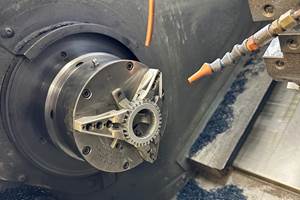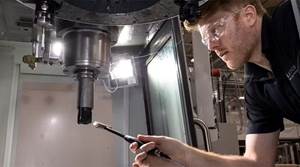Share





Cutting tools are vital to any machining process. All of the engineering that goes into developing a machining center — the kinematics, the axes of movement, the structure of the machine bed, the temperature control systems, the spindle design — not to mention the technology that goes into the CAM system and control — exists to ensure the cutting tool meets the workpiece at the right position, angle and speed. In many ways, it is the vital point at which every program succeeds or fails.
But surely, many shop owners say, here we can skimp on the price.
Choosing the right end mill can make more aggressive machining strategies more attainable, but making the right choice means understanding how the features of the cutting tool affect the process.
Source: All images provided by Kennametal
Of course, it’s not really about the price, but rather about getting the right cutting tool for the right job. Sometimes, that cutting tool will be the cheaper option, but putting careful thought into the cutting tools for a given job will often net a shop improved tool life, faster production speeds, or both. To discuss the considerations that go into cutting tool selection, I spoke with Kennametal global product manager Katie Myers to discuss the engineering that goes into solid carbide end mills.
Cutting Tool Basics
“The design of the cutting edge, coating and flute shape are vital when it comes to chip evacuation and finish,” Myers says. Generally speaking, roughing tools have lower flute counts to increase the space that enables chips to leave the cut, while finishing tools have higher flute counts and sharper edges to improve the finish. Cutting tool manufacturers engineer flute shapes to maximize chip evacuation and apply coatings to increase tool life.
Of course, most machinists work with ferrous metals, and the cutting tools designed for these materials tend to be generalists. “Most of the time, people are working with steel, stainless steel or cast iron, and they want a tool that can do it all.” Some cutting tools like Kennametal’s HARVI line are designed for such wide-ranging applications, with through-coolant capabilities and proprietary designs that reduce chatter and increase tool life.
However, generalist cutting tools will not always enable shops to use the speeds and feeds necessary to produce parts profitably. “Most of the time, any cutting tool will work, but the cutting conditions and how you apply the tool will change,” Myers says. Shops working with non-ferrous materials that want to use aggressive machining strategies or improve chip management are sometimes best served by looking at milling tools designed for specific materials.
Matching Features to Materials
One common misconception is that a cutting tool that can handle steels can surely handle aluminum under similar cutting conditions. “People assume the softer material will cut even easier using the same end mill they use on steel,” she explains, “But if the edges aren’t sharp enough, it’s like cutting into a steak with a butter knife. It doesn’t matter how great the butter knife is, you’re going to tear it instead of shearing.”
This HARVI III Aero is a six-fluted ball nose end mill designed for machining ferrous metals, as well as hardened metals and high-temperature alloys. It also has a relatively thick PVD coating to increase wear resistance, suitable for work on steels and hardened materials. However, this thick coating and higher flute count are less effective when machining aluminum, which requires sharp edges to maintain the desired finish, as well as fewer flutes for better chip evacuation.
The rough edges created by this tearing action can cause the chips to stick together, creating unmanageable swarf that gums up the cutting tool and spindle in addition to leaving a poor finish on the part. This is why cutting tools designed for aluminum often have sharp edges, so sharp that most cutting tool manufacturers do not coat solid end mills designed for aluminum cutting, as even the slight buildup in thickness from the coating can reduce the effectiveness of the cutting edge. Coatings are just not worth it for a lot of aluminum applications, as Myers explains. “Most coatings are designed to improve tool life, but the tool life for end mills used on aluminum tends to be pretty high already.” It is then preferable to focus on maximizing the sharpness of the flute and reducing the number of flutes to make chip evacuation much easier.
Other materials, such as titanium, create whole new problems by upending expectations. While under most circumstances cutting tools with fewer flutes are preferred for roughing and higher flute counts for finishing, titanium can turn this rule on its head. “Roughing titanium is very different,” Myers says. “We encourage people to use dynamic milling — taking a large axial depth of cut and a lower radial depth of cut. This requires increasing the speeds and feeds, and shops can use end mills with higher flute counts to increase the chip load and material-removal rate.” The higher flute count makes chip evacuation more difficult, but Kennametal combats this by including chipbreakers on these tools and developing flute geometries that improve chip evacuation.
The company has also developed coatings like the KCSM15A, which both improves tool life and makes the flutes smoother and more slippery. This helps the chips to slide much more easily, further improving chip evacuation. “[The coating] gives users the ability to increase the cutting parameters and still have higher tool life,” Myers says.
Additionally, Myers emphasizes that while coolant is often recommended for iron and aluminum, it is absolutely necessary for titanium. “Titanium is quite flammable, and without coolant it will likely combust.”
At the end of the day, however, Myers says it is how a machinist applies the tool that matters. “You can make a cutting tool work in a lot of different situations, but you need to approach each material differently, from machining strategy to toolpath to machining parameters,” she explains. “Using cutting tools designed for certain materials lets users machine more aggressively, but it’s up to the shop to consider which strategy serves them best.”
Related Content
Chuck Jaws Achieve 77% Weight Reduction Through 3D Printing
Alpha Precision Group (APG) has developed an innovative workholding design for faster spindle speeds through sinter-based additive manufacturing.
Read MoreEight Articles to Understand Live Tooling
A roundup of the most read articles about live tooling on 91±¬ÁĎÍř.
Read MoreShop Reclaims 10,000 Square Feet with Inventory Management System
Intech Athens’ inventory management system, which includes vertical lift modules from Kardex Remstar and tool management software from ZOLLER, has saved the company time, space and money.
Read MoreHow to Mitigate Chatter to Boost Machining Rates
There are usually better solutions to chatter than just reducing the feed rate. Through vibration analysis, the chatter problem can be solved, enabling much higher metal removal rates, better quality and longer tool life.
Read MoreRead Next
How I Made It: Dennis Rymanowski
Dennis Rymanowski has worked at NSH USA for 60 years, with his passion for manufacturing living alongside his passion for his family’s polka band.
Read MoreA New Frontier in Surface Finish Control
What if your machine tool could measure surface roughness as it cuts? This article explores how in-process metrology is advancing from concept to reality, enabling real-time feedback, immediate detection of anomalies and new levels of control over surface quality. Discover the technologies making this possible.
Read More























